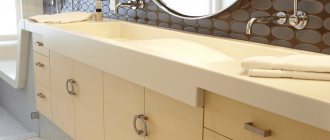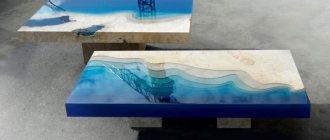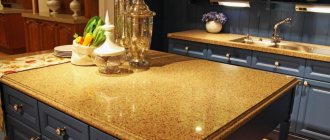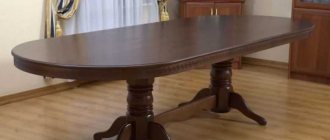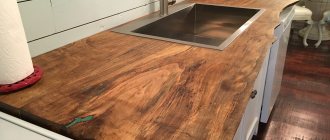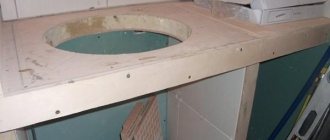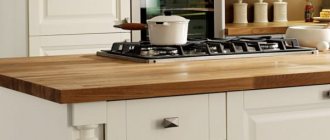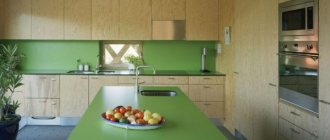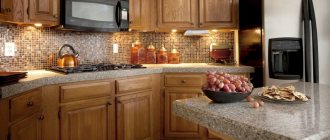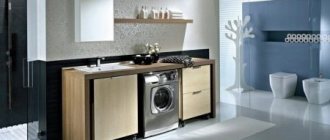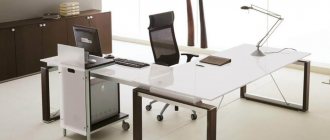How to make a countertop from epoxy resin with your own hands: recommendations
Before work, you need to make sure that the room is well ventilated. The optimal air temperature will be 22°C. Dust and high humidity will negatively affect the result.
You also need to prepare a release agent. Wax is suitable for home use. The tools you will need are a grinding device and abrasive paper of different grain sizes.
Personal protective equipment must not be neglected. Goggles, a mask or respirator, and gloves are required. A cap on your head and a robe will not be superfluous.
It is worth covering the floor and other surfaces near the work area with film, this will help protect them from resin drops.
Testing
Before using the composition, it is recommended to test it to determine its properties (including dyes and fillers). The test can be carried out on a small volume, for example, in a plastic cup.
Working with material
Each product requires an individual approach to choosing the material and working with it. But the basic rule is that the lower the fill height, the more likely it is that you will like the result.
In terms of reaction time, compounds can be fast or slow.
- It is better to pour quick compositions (4-6 hours per layer) in layers and follow the manufacturer's instructions. Each subsequent layer can be poured after the resin in the previous layer has hardened and cooled to approximately 30°C.
- Slow compositions (2-3 days of complete curing) can be poured in large layers, and the manufacturer’s recommendations should not be ignored.
It is important to follow the principle: the larger the pouring area, the smaller the layer should be.
Post-curing
Any epoxy mixture turns yellow after complete curing. The duration of the shade change depends on the type of hardener.
If, after hardening, the composition does not turn yellow, this indicates that the reaction has not been completed completely. To bring the material to final curing, it is necessary to heat it for 4 hours at a temperature of 60°C.
Preparation of wood parts
The wooden elements of the countertop must be completely dry.
Before directly pouring the “river”, it is necessary to prime all places where the resin comes into contact with the wood. The USF 847 insulator is suitable for this.
in a ratio of 100:100, applied to the surface of the array in 2 layers. This will create a “cup” for the pour and will also prevent air from escaping from the wood.
If this is not done, there is a risk of losing a significant part of the volume of the mixture, because it can go significantly into the wood or almost completely onto the floor. Casting compounds are slightly denser than water, therefore they are quite fluid.
Temperature control in the room and in the filling
During the reaction, it is imperative to monitor the temperature of the layers. Otherwise, the resin will turn very yellow and bubbles will form inside. This effect can be caused by the use of a burner, so its use is highly undesirable.
In high-quality and well-mixed resin, air bubbles come out on their own without the use of additional means.
Use a non-contact pyrometer to monitor the temperature.
Grinding at minimum speed
Without quality grinding there will be no good polishing. Grinding helps eliminate a number of defects: sharp edges, air bubbles protruding to the surface, smudges and waves. The surface is smoothed, and the product acquires a finished appearance.
It is necessary to clean the layers from any dust generated during the grinding procedure.
Grinding of the resin part must be carried out at minimum speed (no more than 600 rpm), otherwise the resin may begin to melt.
Peculiarities
The store will likely stock a number of two-component compounds consisting of a base material and a hardener. In this form, epoxy is most suitable for work. Before mixing, the components remain in liquid form for an indefinitely long time, which means that the master can begin preparing the composition and pouring it when it is convenient for him, without time restrictions.
During the polymerization process, the compound retains its volume without shrinking. The transparency of the resin does not change when exposed to ultraviolet radiation, so the countertops retain their aesthetic appearance throughout their entire service life. The fluidity of the resin allows you to decorate the tabletop slab in a variety of ways. Despite the strength of the material, the resin can melt when exposed to high temperatures. Surfaces cannot be polished or ground using an angle grinder.
The cost of epoxy resin is difficult to estimate objectively. For one kilogram of compound you will have to pay from 700 to 1500 rubles, depending on the brand and manufacturer.
If we compare the cost of production with the cost of the finished product, the material turns out to be relatively inexpensive. Alternative options exist, however, in order for them to have similar strength, waterproofing, and durability, additional processing will have to be carried out, which will entail an increase in costs.
Epoxy resin performs several functions at the same time. In addition to creating a transparent surface, it serves as a material to stabilize the wood. The compound not only covers the wood from above, but also penetrates into the smallest pores. By the way, if photographs, natural materials, or plant flowers are used as decoration, then under a layer of epoxy they remain in their original form for a long time. Some designers see shading as a way to preserve family photos.
The potential of resin in artistic creation should also be appreciated. By varying the color, the master can create an imitation of bodies of water, the starry sky, and flora. Ideas of an abstract nature are also interesting. By adding a phosphor to the composition, luminous elements are obtained. In addition, the dielectric properties of epoxy make it possible to install electrical circuits for lighting. LED strips are usually used as a light source.
Useful to know > Epoxy resin Art-solid from Ekovanna
Buy epoxy resin for pouring countertops in Moscow
There are several ways to purchase epoxy resin in Moscow:
• Pickup
from the office warehouse at st. 4-ya Kabelnaya, 2, building 1.
Office and warehouse opening hours: 09:00 - 19:00 on weekdays and 12:00 - 16:00 on Saturday.
• Delivery within the Moscow Ring Road:
from 750 rubles for a weight up to 100 kg and from 1,500 rubles for a weight from 100 to 500 kg.
• Delivery to the transport company terminal
(SDEK, Business Lines, PEC, Magic Trans, Baikal Service): from 200 rubles.
Review of popular brands
The list below is not absolute. The popularity of epoxy resin brands is determined according to reviews from real customers. Naturally, different interpretations of reviews can be found in different sources. However, the above list is quite enough to start your creative and artistic activities without proper experience.
- QTP-1130. This brand is positioned as a resin for pouring countertops. It’s safe to say that this is a universal option for beginners who do not want to go into details of the technical characteristics of the material. The maximum layer thickness is about 3 mm. Pouring in one step is possible only if there is decor made of wood, stone or slab. The resin is transparent. It does not get a yellow tint after curing, so the tabletops are decorated with pictures or photographs. Low viscosity promotes self-leveling. QTP-1130 is most often used in the manufacture of coffee tables or small desks.
- Art-Eco. The research and production facility is engaged in the development and production of epoxy resins for household use. All products are released under the Art-Eco brand. The attention of buyers is attracted by the variety of accessories. In addition to the main material, the buyer is offered a huge selection of colors and pigment pastes. A solvent for epoxy resin has also been developed. It is used when necessary to reduce the viscosity of the compound. The resin is distinguished by its suitability for pouring thin layers. The maximum layer thickness does not exceed 5-7 mm. In general, reviews about this model are positive, but there are some negative points. The material is very demanding in maintaining proportions. The slightest deviation from the recommended values leads to incomplete curing or an increase in viscosity. In conditions of forming a flat horizontal surface, this is unacceptable. In addition, many craftsmen complain about the appearance of a yellow tint, although it is barely visible in the light. It is recommended to use the resin in conjunction with any color.
- ED-20. This brand of resin is causing endless controversy in various forums. She has her fans and critics. It must be admitted that ED-20 is considered a classic, since it is the only resin on our list produced in accordance with GOST. By the way, its name is also written in the specified document. It no longer meets modern requirements. High viscosity causes air bubbles to appear that do not have time to reach the surface. The master has to make extra efforts to get rid of them. It is also noted that the transparency of the compound decreases over time, and the polymer itself acquires a yellowish tint. The model has several modifications that are characterized by increased strength, but they are more in demand for pouring floors in technical rooms. ED-20 does not lose its popularity only due to its low cost. It is this quality that is valued by those who decide to try their hand and gain the necessary experience before performing more jewelry work.
Useful to know > Famous Moment epoxy adhesive and its varieties
- CHS Epoxy 520. There is not much to say about this model. All you need to know is that it is perfect for the most difficult jobs. Complexity refers to the presence of decor made from natural materials in the tabletop. The compound goes well with the herbarium, and there are no difficulties when pouring it. It is known that viscous resins have a mechanical effect on dry flowers and plant petals, as a result of which the decor has to be leveled. CHS Epoxy 520 resin in combination with 921 OP hardener has high adhesion. The tabletop can be decorated with metal, wood or plastic. The material from the Czech manufacturer is called an improved analogue of ED-20. Indeed, this resin is devoid of the shortcomings that were inherent in the model that appeared in Soviet times. An important quality is the absence of boiling even when filling large volumes.
- Crystal Glass. Crystal Glass resin is produced in the city of Yaroslavl. It is sold in plastic bottles of 200 g. The kit also includes a hardener. This resin has high fluidity, making it ideal for filling large areas. But with the proper technique, it can be used as a jewelry compound. It is necessary to gain at least basic experience in order to vary the viscosity. After mixing the components, the resin is infused for some time, and its viscosity increases. The master's task is to determine after what time pouring should begin.
- PEO-610KE. This brand of compound, like ED-20 resin, is certified according to GOST. The letter “E” in the name indicates that the material is elastic after curing. For the production of countertops, this property is of great importance. Elasticity allows you to distribute the load under mechanical stress. The resin's lifetime is 4 hours, and complete curing occurs 54 hours after preparing the composition. Resin is in the middle price category. For 150 grams of the main component you will have to pay about 600 rubles. The hardener for PEO-610KE must be ordered separately from the manufacturer. It is suitable for all modifications of resins of this brand.
- EpoxAcast 690. EpoxAcast 690 resin is presented by Russian. It is positioned as a compound for making jewelry. As a material for countertops, the brand is interesting because it allows you to fill a layer of up to 5 cm. Unlike the previous model, this resin is not elastic. After curing, it shrinks slightly, but the transparency is not lost. The manufacturer simultaneously delivers the goods. For 1 kg of resin, the buyer will pay 2000 rubles.
- MG-EPOX-STRONG. German quality never fails. Many experienced craftsmen who work with MG-EPOX-STRONG write about this. Many master classes recommend filling countertops with this particular material. The only drawback that buyers could find was the long curing time. The resin product can only be used 3 days after pouring. The resin is called ultra-transparent and ultra-strong for its technical characteristics.
- Epoxy CR 100. Epoxy CR 100 resin has fairly high performance, so it is used as a universal material. The brand was included in the rating list not only because of its technical parameters. Epoxy CR 100 resin is harmless even in liquid state. Protective equipment will only be needed to protect items of clothing.
